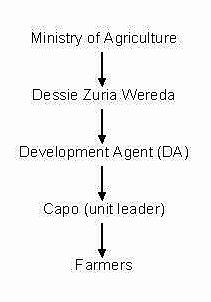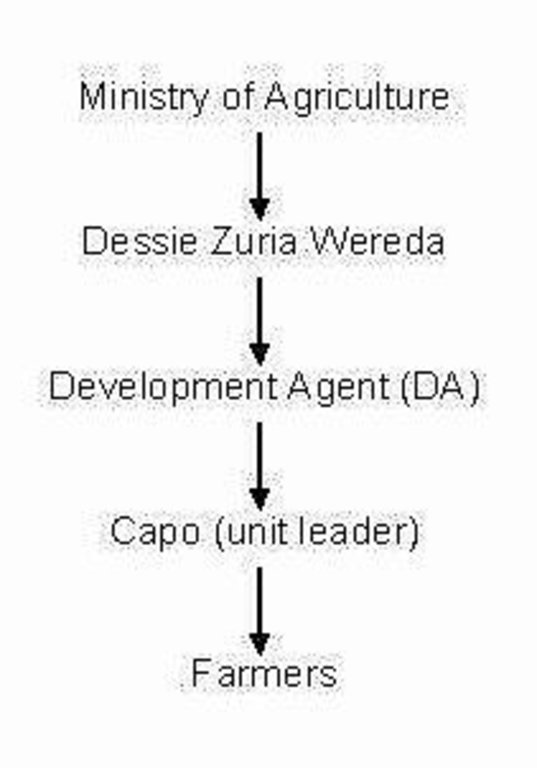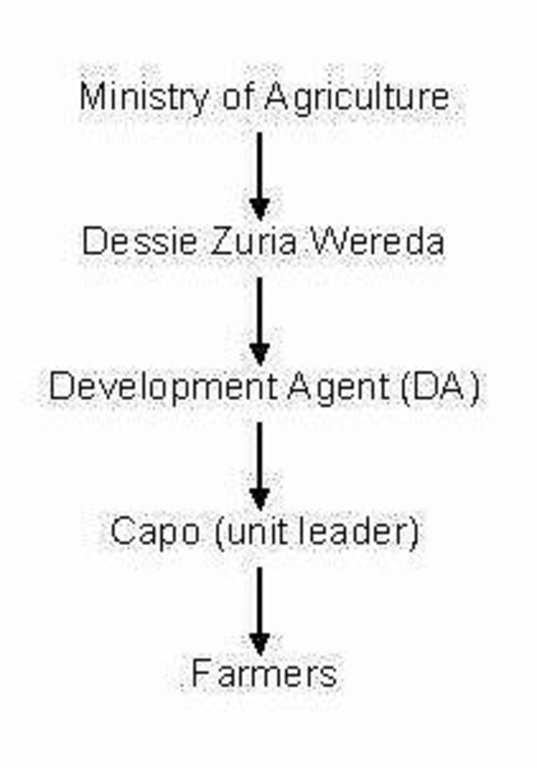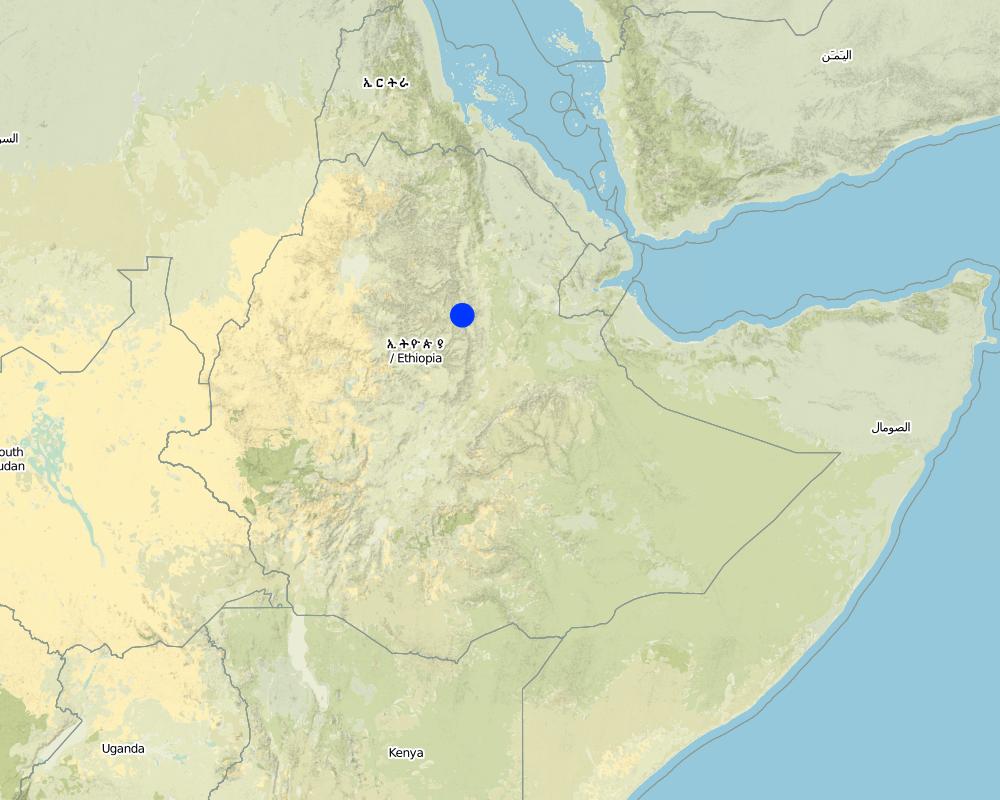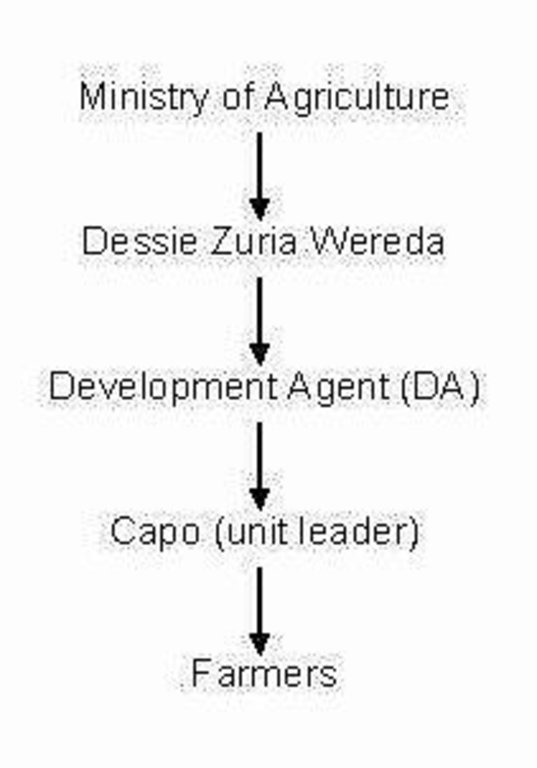food-for-work programm [Ethiopie]
- Création :
- Mise à jour :
- Compilateur : Sabina Erny
- Rédacteur : –
- Examinateur : Fabian Ottiger
approaches_2554 - Ethiopie
Voir les sections
Développer tout Réduire tout1. Informations générales
1.2 Coordonnées des personnes-ressources et des institutions impliquées dans l'évaluation et la documentation de l'Approche
1.3 Conditions relatives à l'utilisation par WOCAT des données documentées
Le compilateur et la(les) personne(s) ressource(s) acceptent les conditions relatives à l'utilisation par WOCAT des données documentées:
Oui
1.4 Références au(x) questionnaire(s) sur les Technologies de GDT
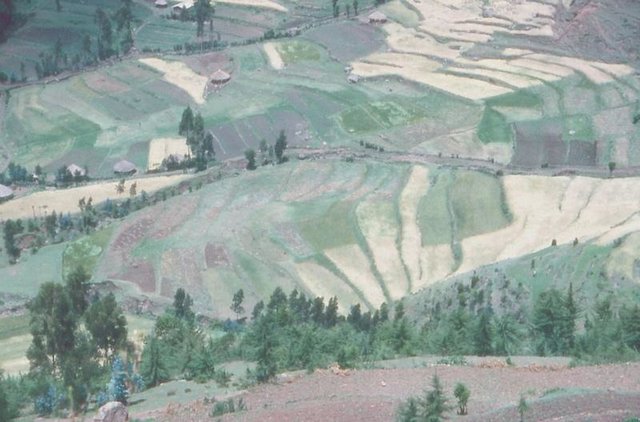
level bund with double stone walls [Ethiopie]
level bund with double stone walls with soil and grass to stabilize the structure
- Compilateur : Sabina Erny
2. Description de l'Approche de GDT
2.1 Courte description de l'Approche
food-for-work programm with distribution of grains and oil
2.2 Description détaillée de l'Approche
Description détaillée de l'Approche:
Aims / objectives: Overall purpose: contribute to the SWC of the area; Specific objectives: build the level bunds, reforestation and the cut-off drains
Methods: Incentives for work
Stages of implementation: Collect farmers, tell them about the conservation, they formed groups/units who worked under a unit leader (capo=chief)
Role of stakeholders: Farmers carried out the work, the construction of the level bunds, the planting of trees. The technician told them what to do. Passive role of the farmers.
Other important information: Discussion started after implementation when farmers came to eht research station to get advice what they could do about the narrow terraces on the steep steep slopes and against the rats. Together they found a solution.
2.3 Photos de l'approche
2.5 Pays/ région/ lieux où l'Approche a été appliquée
Pays:
Ethiopie
Région/ Etat/ Province:
South Wello
Map
×2.6 Dates de début et de fin de l'Approche
Indiquez l'année de démarrage:
1983
Date (année) de fin de l'Approche (si l'Approche n'est plus appliquée):
1985
2.7 Type d'Approche
- fondé sur un projet/ programme
2.8 Principaux objectifs de l'Approche
The Approach focused mainly on SLM with other activities (1984 construction of water channel for water pump for an irrigation project (outside of described catchment, but affectsuing people within catchment as well), road from main road Dessie-Jemme-Borana down to lake was constructed through the same approach)
give food and get work for it; not just getting the food even though there was a drought, but the people received only food if they worked for it
The SLM Approach addressed the following problems: drought, to improve the field qualities, prevention of erosion, to give the hungry farmers food because they were suffering from shortage of food
2.9 Conditions favorisant ou entravant la mise en œuvre de la(des) Technologie(s) appliquée(s) sous l'Approche
normes et valeurs sociales/ culturelles/ religieuses
- entrave
farmers were weak because of drought
Treatment through the SLM Approach: food helped because they got it every 2 weeks
disponibilité/ accès aux ressources et services financiers
- entrave
time-consuming activities
Treatment through the SLM Approach: food-for-work
cadre juridique (régime foncier, droits d'utilisation des terres et de l'eau)
- favorise
The existing land ownership, land use rights / water rights helped a little the approach implementation
connaissances sur la GDT, accès aux supports techniques
- entrave
not enough material
Treatment through the SLM Approach: shovel, hoes lend to the farmers
3. Participation et rôles des parties prenantes impliquées dans l'Approche
3.1 Parties prenantes impliquées dans l'Approche et rôles
- exploitants locaux des terres / communautés locales
Working land users were mainly men (also some women)
The capo is a man; it is the culture and tradition that men work on the field, women collect stones; men dig lines, bring soil with the shovel, build stone walls
- gouvernement national (planificateurs, décideurs)
- organisation internationale
Si plusieurs parties prenantes sont impliquées, indiquez l'organisme chef de file ou l'institution responsable:
Designed by SIDA
3.2 Participation des exploitants locaux des terres/ communautés locales aux différentes phases de l'Approche
| Participation des exploitants locaux des terres/ communautés locales | Spécifiez qui était impliqué et décrivez les activités | |
|---|---|---|
| initiation/ motivation | aucun | |
| planification | passive | information |
| mise en œuvre | soutien extérieur | Mainly: casual labour; partly: responsibility for major steps; the capo has a greater responsibility |
| suivi/ évaluation | aucun | |
| Research | passive | on-station |
3.3 Diagramme/ organigramme (si disponible)
3.4 Prises de décision pour la sélection de la Technologie/ des Technologies
Indiquez qui a décidé de la sélection de la Technologie/ des Technologies à mettre en œuvre:
- les spécialistes de la GDT seuls
Expliquez:
Decisions on the method of implementing the SLM Technology were made by by SLM specialists alone (top-down)
4. Soutien technique, renforcement des capacités et gestion des connaissances
4.1 Renforcement des capacités/ formation
Une formation a-t-elle été dispensée aux exploitants des terres/ autres parties prenantes?
Oui
Spécifiez qui a été formé:
- exploitants des terres
- SWC specialists
Formats de la formation:
- zones de démonstration
- réunions publiques
Thèmes abordés:
the cattle should not enter the cultivated land until bund is established; how to maintain the bunds was also demonstrated
4.2 Service de conseils
Les exploitants des terres ont-ils accès à un service de conseils?
Oui
Spécifiez si le service de conseils est fourni:
- dans des centres permanents
Décrivez/ commentez:
1) Advisory service was carried out through: projects own extension structure and agents; Extension staff: mainly government employees 2) Target groups for extension: land users
Advisory service is inadequate to ensure the continuation of land conservation activities; they need new, different technologies, another training to give to the people
4.3 Renforcement des institutions (développement organisationnel)
Des institutions ont elles été mises en place ou renforcées par le biais de l'Approche?
- non
4.4 Suivi et évaluation
Le suivi et l'évaluation font ils partie de l'Approche? :
Oui
Commentaires:
technical aspects were ad hoc monitored through observations
There were no changes in the Approach as a result of monitoring and evaluation
4.5 Recherche
La recherche a-t-elle fait partie intégrante de l’Approche?
Oui
Spécifiez les thèmes:
- sociologie
- écologie
Donnez plus de détails et indiquez qui a mené ces recherches:
it was especially undertaken for the environment
Research was carried out on station
5. Financement et soutien matériel externe
5.1 Budget annuel de la composante GDT de l'Approche
Commentez (par ex. principales sources de financement/ principaux bailleurs de fonds):
Approach costs were met by the following donors: international non-government (WFP): 100.0%
5.2 Soutiens financiers/ matériels fournis aux exploitants des terres
Les exploitants des terres ont-ils reçu un soutien financier/ matériel pour la mise en œuvre de la Technologie/ des Technologies?
Oui
5.3 Subventions pour des intrants spécifiques (incluant la main d'œuvre)
- équipement
| Spécifiez les intrants subventionnés | Dans quelle mesure | Spécifiez les subventions |
|---|---|---|
| outils | en partie financé | Hand tools |
Si la main d'œuvre fournie par les exploitants des terres était un intrant substantiel, elle était:
- vivres-contre-travail
Commentaires:
grains and oil
5.4 Crédits
Des crédits ont-ils été alloués à travers l'Approche pour les activités de GDT?
Non
6. Analyses d'impact et conclusions
6.1 Impacts de l'Approche
Est-ce que l'Approche a aidé les exploitants des terres à mettre en œuvre et entretenir les Technologies de GDT?
- Non
- Oui, un peu
- Oui, modérément
- Oui, beaucoup
terraces
Did other land users / projects adopt the Approach?
- Non
- Oui, un peu
- Oui, modérément
- Oui, beaucoup
6.3 Durabilité des activités de l'Approche
Les exploitants des terres peuvent-ils poursuivre ce qui a été mis en œuvre par le biais de l'Approche (sans soutien extérieur)?
- incertain
Si non ou incertain, spécifiez et commentez:
only some of them can because it needs lots of labor and time
6.4 Points forts/ avantages de l'Approche
| Points forts/ avantages/ possibilités du point de vue de l'exploitant des terres |
|---|
| incentives are good to start the project (How to sustain/ enhance this strength: give food, material) |
| they learned a lot from the project (How to sustain/ enhance this strength: give them more information, train them) |
| they were happy to get some food |
| Points forts/ avantages/ possibilités du point de vue du compilateur ou d'une autre personne ressource clé |
|---|
| pass on information, trainings (How to sustain/ enhance this strength: give more information and trainings) |
6.5 Faiblesses/ inconvénients de l'Approche et moyens de les surmonter
| Faiblesses/ inconvénients/ risques du point de vue de l’exploitant des terres | Comment peuvent-ils être surmontés? |
|---|---|
| payment was fixed, but because of the drought, the farmers were too weak to work | payment should be flexible |
| top-down | more bottom-up |
| Faiblesses/ inconvénients/ risques du point de vue du compilateur ou d'une autre personne ressource clé | Comment peuvent-ils être surmontés? |
|---|---|
| not having asked the farmers; top-down approach | involve farmers from the beginning, so they feel needed and useful |
| local knowledge has not been considered | ask the farmers and integrate their knowledge |
| incentive food should be reconsidered especially because it was not flexible and there was a drought and they strictly distributed it according to their measures and not according to the situation | no strict calulation formula of the food, so there is space to give more food if needed as it would have been the case here since there was a serious drought at the stage of implementation |
7. Références et liens
7.1 Méthodes/ sources d'information
- visites de terrain, enquêtes sur le terrain
- interviews/entretiens avec les exploitants des terres
Liens et modules
Développer tout Réduire toutLiens

level bund with double stone walls [Ethiopie]
level bund with double stone walls with soil and grass to stabilize the structure
- Compilateur : Sabina Erny
Modules
Aucun module trouvé


